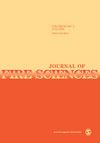In-depth temperature and smoke production of charring wood under a constant external heat flux
IF 1.9
4区 工程技术
Q2 ENGINEERING, MULTIDISCIPLINARY
引用次数: 0
Abstract
The combustion characteristics of charring wood have been studied experimentally in a well-ventilated environment of a smoke chamber. A numerical simulation has also been performed for a limited case, with the Fire Dynamics Simulator, to estimate the burning environment. A horizontally placed specimen (ponderosa pine) with a moisture content of 0% or 20% is exposed to a radiant flux (25 kW/m2), with or without flaming ignition. Simultaneous measurements of the specimen’s in-depth temperature and the mass loss determine the charring front (rate) at 300 °C and the gasification rate, respectively. These condensed-phase conditions relate directly to real-time variations of gas-phase quantities: the specific optical density of smoke and the concentrations of toxic gases measured by a Fourier transform infrared gas analyzer. In-depth temperature trends are similar whether the flame exists, whereas the smoke and toxicants’ concentrations are substantially different. After the charring front moves through the specimen, the oxidative pyrolysis continues under the irradiation at high temperatures (up to ∼550 °C). Carbon monoxide and acrolein are produced continuously throughout the test, and the results indicate strong correlations. Although char formation of wood is favorable for fire safety, consequent incomplete combustion produces smoke and toxicants.恒定外部热通量下炭化木材的深度温度和产烟
在通风良好的烟室环境中,对炭化木材的燃烧特性进行了实验研究。还使用火灾动力学模拟器对有限情况进行了数值模拟,以估计燃烧环境。将水分含量为0%或20%的水平放置的样品(黄松)暴露于辐射通量(25 kW/m2),具有或不具有火焰点火。样品深度温度和质量损失的同时测量确定了300时的炭化前沿(速率) °C和气化速率。这些凝聚相条件与气相量的实时变化直接相关:通过傅立叶变换红外气体分析仪测量的烟雾的比光密度和有毒气体的浓度。无论火焰是否存在,深度温度趋势都是相似的,而烟雾和有毒物质的浓度则大不相同。炭化前沿穿过试样后,在高温(高达~550 °C)。一氧化碳和丙烯醛在整个测试过程中不断产生,结果表明它们之间存在很强的相关性。尽管木材形成焦炭有利于消防安全,但随之而来的不完全燃烧会产生烟雾和有毒物质。
本文章由计算机程序翻译,如有差异,请以英文原文为准。
求助全文
约1分钟内获得全文
求助全文
来源期刊

Journal of Fire Sciences
工程技术-材料科学:综合
CiteScore
4.00
自引率
0.00%
发文量
14
审稿时长
2.5 months
期刊介绍:
The Journal of Fire Sciences is a leading journal for the reporting of significant fundamental and applied research that brings understanding of fire chemistry and fire physics to fire safety. Its content is aimed toward the prevention and mitigation of the adverse effects of fires involving combustible materials, as well as development of new tools to better address fire safety needs. The Journal of Fire Sciences covers experimental or theoretical studies of fire initiation and growth, flame retardant chemistry, fire physics relative to material behavior, fire containment, fire threat to people and the environment and fire safety engineering. This journal is a member of the Committee on Publication Ethics (COPE).
 求助内容:
求助内容: 应助结果提醒方式:
应助结果提醒方式:


